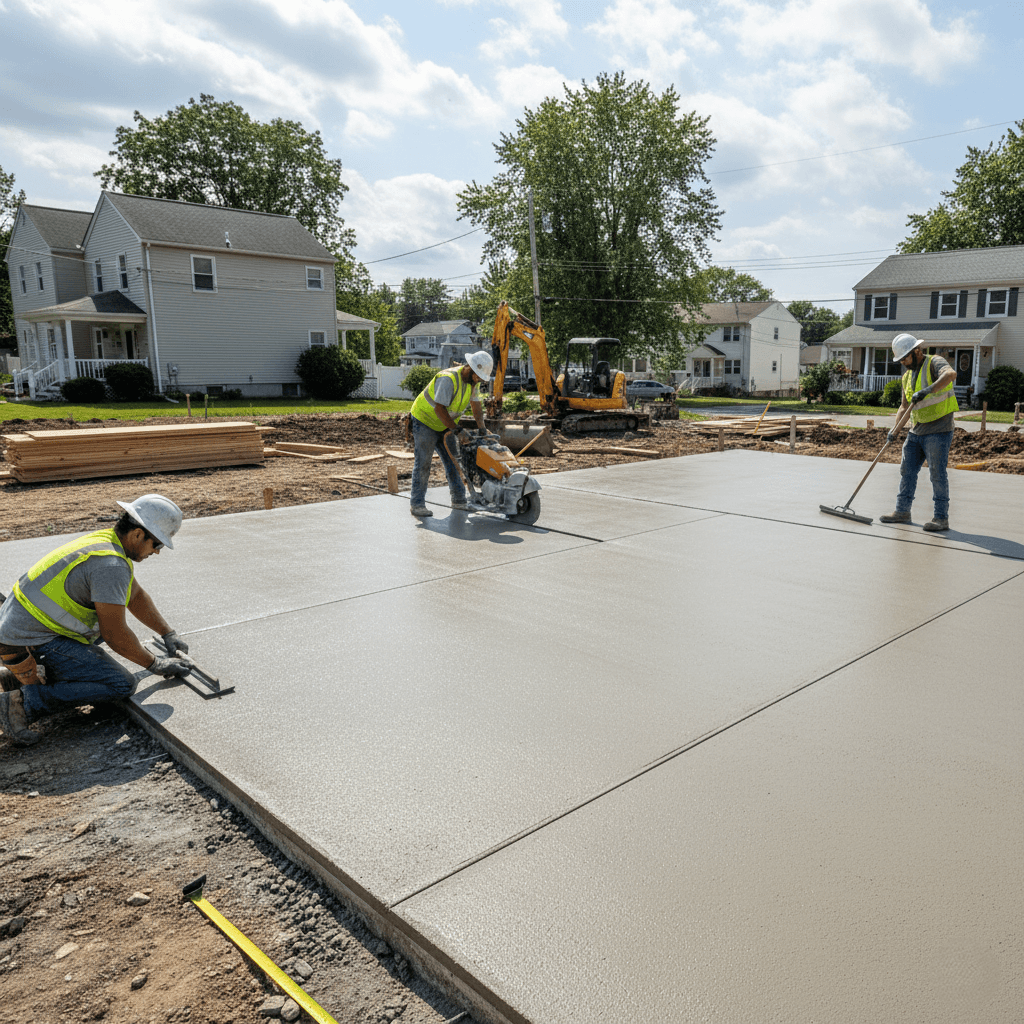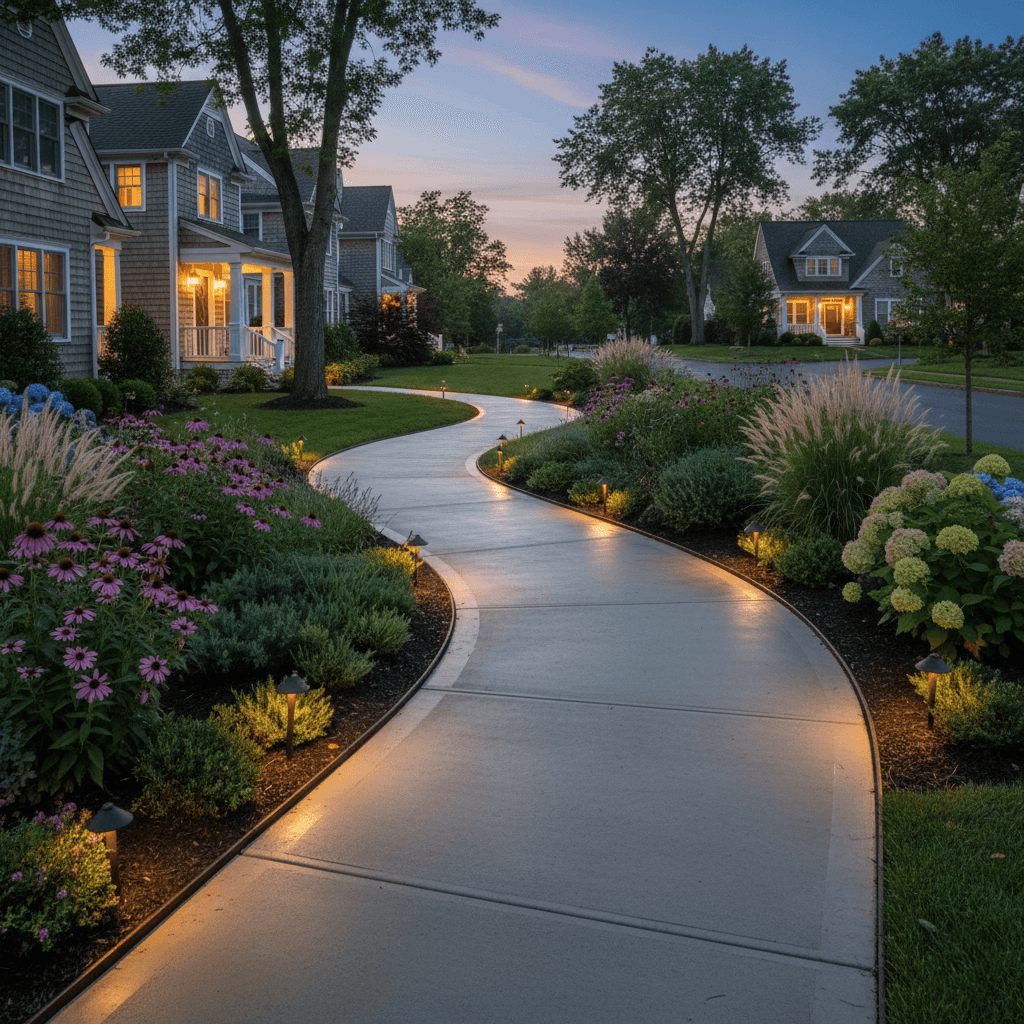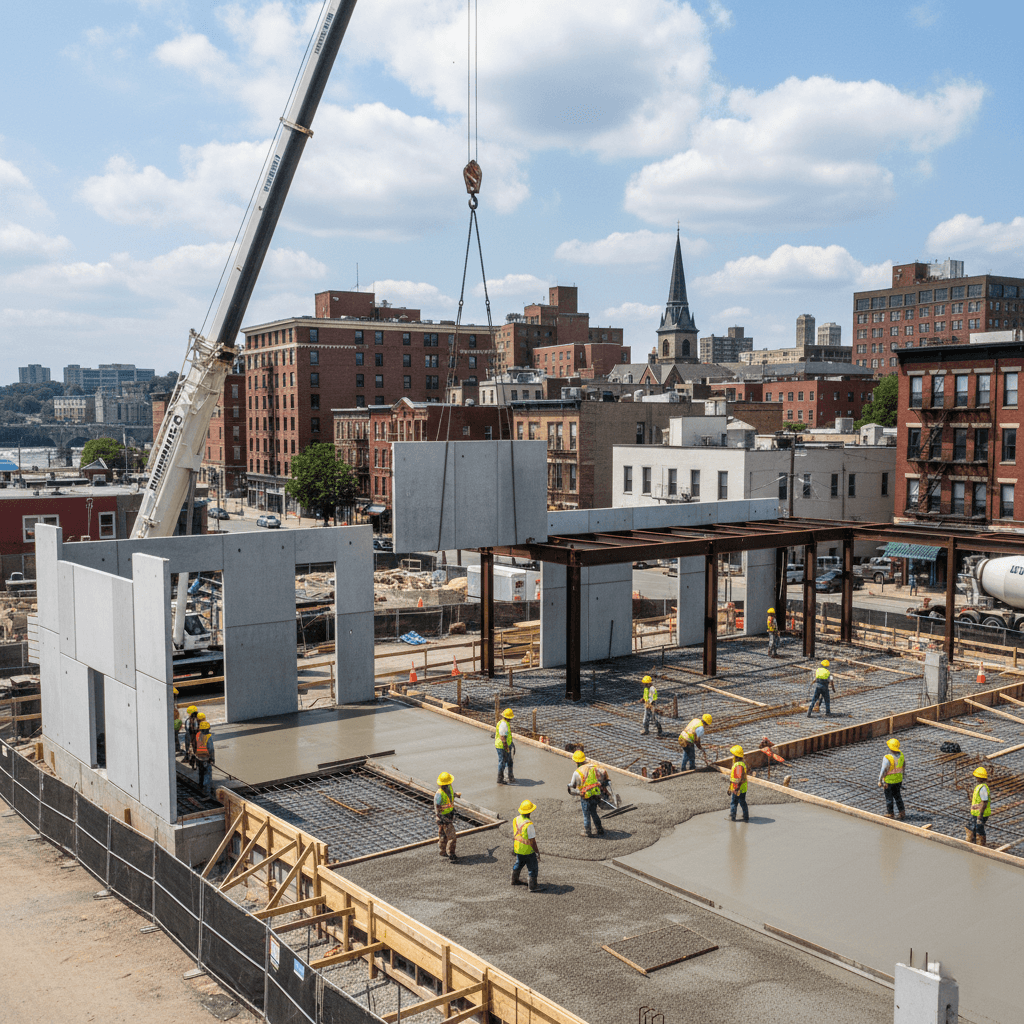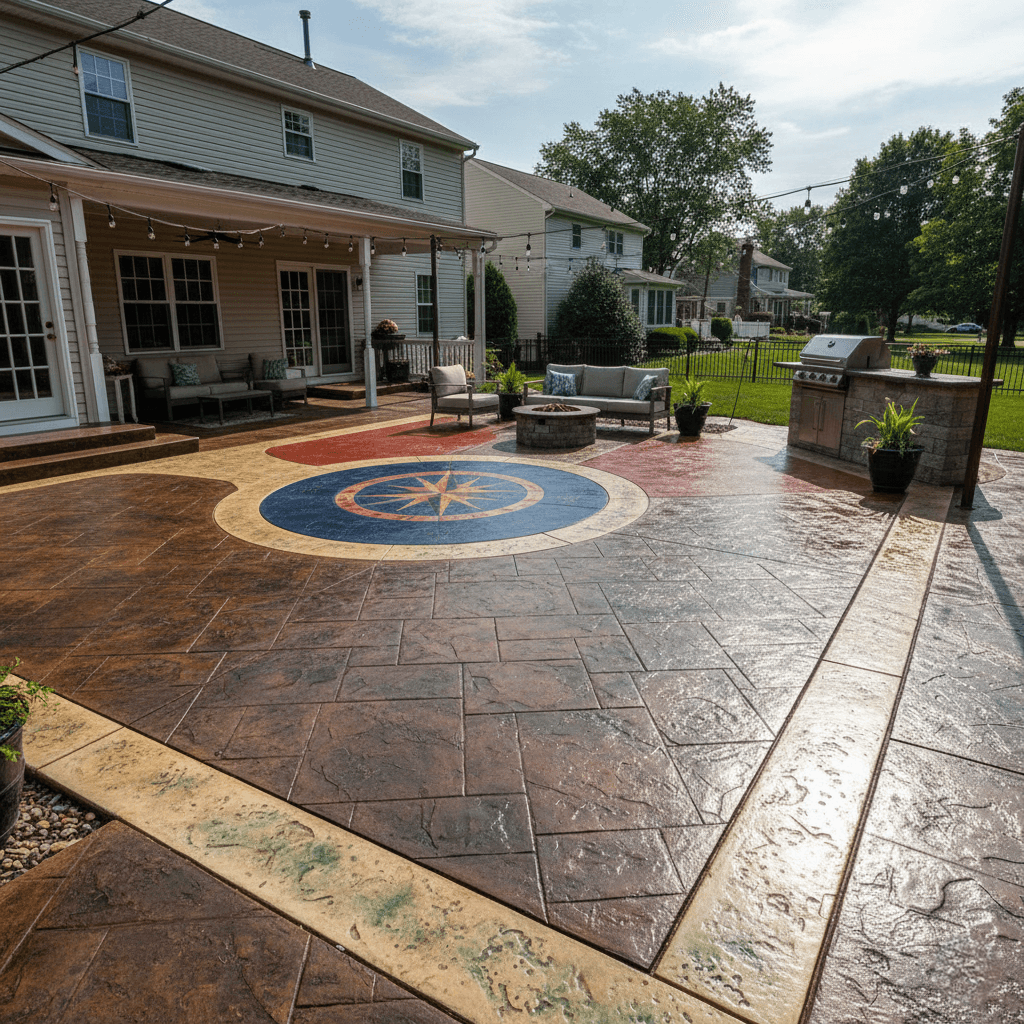
Paterson Concrete Walkways: Lighting & Landscape Tips
Concrete Walkway Paterson
Creating stunning concrete walkways in Paterson, NJ, involves integrating thoughtful lighting design and strategic landscaping to enhance both functionality and aesthetic appeal. Professional walkway design combines durable concrete construction with carefully planned lighting systems that provide safety while highlighting architectural features and surrounding gardens. Additionally, proper landscape integration transforms utilitarian pathways into inviting outdoor corridors that connect different areas of your property seamlessly. Understanding how lighting and landscaping work together helps homeowners create walkways that serve as focal points while providing practical navigation throughout their outdoor spaces. Moreover, well-designed concrete walkways with integrated lighting and landscaping significantly increase property values while creating memorable first impressions for visitors.

Strategic Lighting Design for Safety and Ambiance
Effective walkway lighting design balances safety requirements with aesthetic goals, ensuring pathways remain navigable while creating inviting outdoor atmospheres. LED pathway lighting provides energy-efficient illumination that lasts over 50,000 hours while offering consistent, bright light output throughout the evening hours. Additionally, low-voltage landscape lighting systems reduce energy costs while providing safer installation processes compared to standard electrical connections. Professional lighting designers recommend spacing fixtures every 6-8 feet along concrete walkways to eliminate dark spots and ensure continuous visibility. Furthermore, dimmer controls allow homeowners to adjust lighting intensity based on usage patterns and seasonal requirements.
Path Light Placement and Fixture Selection
Proper fixture placement along concrete walkways requires careful consideration of light distribution patterns, shadow elimination, and visual appeal during both day and night. Downward-facing fixtures prevent glare while directing light precisely where needed for safe navigation along pathway surfaces. Moreover, discrete black path lights tucked along walkway edges provide effective illumination without overwhelming the landscape design aesthetic. Professional installations include proper electrical planning with buried conduits and weather-resistant connections that withstand New Jersey’s challenging climate conditions. Additionally, fixture selection should complement home architecture and existing landscape elements while providing adequate illumination for safe passage.
Landscape Integration and Plant Selection
Strategic landscape integration transforms concrete walkways from simple pathways into garden features that enhance overall property design and curb appeal. Walkway plant selection requires understanding local growing conditions, seasonal interest patterns, and maintenance requirements for sustainable long-term performance. Additionally, native New Jersey plants provide environmental benefits while reducing water requirements and maintenance needs compared to non-native species. Professional landscape designers recommend layering plants at different heights to create visual interest while maintaining clear sight lines for safety. Furthermore, proper plant placement ensures mature sizes don’t interfere with lighting fixtures or walkway surfaces over time.
Seasonal Interest and Year-Round Appeal
Creating year-round landscape interest along concrete walkways requires selecting plants that provide seasonal variety through flowers, foliage, bark, and structural elements. Spring bulbs, including crocuses, daffodils, and tulips, provide early-season color that welcomes visitors after the winter months. Moreover, summer perennials like Russian sage, switchgrass, and native wildflowers offer sustained blooms and texture throughout growing seasons. Fall selections, including Japanese maples, burning bush, and ornamental grasses, provide dramatic color changes that highlight walkway design. Additionally, evergreen elements ensure visual interest during winter months while providing structure and defining pathway edges year-round.
Design Coordination and Material Integration
Successful walkway design requires coordinating concrete finishes, lighting fixtures, and landscape elements to create cohesive outdoor environments that complement home architecture. Stamped concrete patterns can echo architectural details while providing textural interest that enhances both lighting effects and plant displays. Additionally, color coordination between concrete tones, lighting fixtures, and seasonal plant colors creates harmonious designs that feel intentional and professionally planned. Material selection should consider durability, maintenance requirements, and long-term performance in Paterson’s variable climate conditions. Furthermore, quality materials and professional installation ensure walkway systems perform reliably while maintaining aesthetic appeal over many years.
Texture and Pattern Considerations
Concrete texture selection significantly impacts both lighting effects and landscape integration, with different finishes creating varied shadow patterns and visual relationships. Smooth troweled surfaces reflect light efficiently while providing clean, modern appearances that complement contemporary landscape designs. Moreover, broom-finished concrete offers slip resistance while creating a subtle texture that enhances safety during wet conditions common in New Jersey. Stamped patterns, including ashlar slate, flagstone, and brick designs, provide sophisticated appearances that coordinate well with traditional and transitional architectural styles. Additionally, exposed aggregate finishes offer natural textures that blend seamlessly with surrounding landscape elements while providing excellent traction.
Water Management and Drainage Solutions
Proper drainage design prevents water accumulation that can damage concrete walkways, compromise lighting systems, and harm landscape plantings throughout Paterson’s variable weather patterns. Grading walkways with subtle slopes directs water away from high-traffic areas while preventing pooling that creates safety hazards and ice formation. Additionally, permeable jointing materials and strategic drainage systems manage stormwater runoff while protecting surrounding landscape areas from erosion. Professional installation includes French drains, catch basins, and grading modifications that handle heavy rainfall events while maintaining walkway functionality. Furthermore, proper drainage extends the lifespan of both hardscape and landscape elements while reducing maintenance requirements.
Plant Selection for Drainage Areas
Strategic plant selection near drainage areas helps manage water flow while creating attractive landscape features that enhance walkway design and environmental performance. Rain gardens featuring native sedges, ferns, and moisture-tolerant perennials provide natural stormwater management while adding ecological value to residential landscapes. Moreover, plants like Pennsylvania sedge, little bluestem, and native asters thrive in variable moisture conditions while providing habitat for beneficial insects and birds. Proper plant placement channels water effectively while preventing erosion that could undermine walkway stability or compromise lighting installations. Additionally, deep-rooted native plants improve soil structure and water infiltration rates while reducing surface runoff that affects neighboring properties.
Maintenance Considerations and Long-term Care
Sustainable walkway design includes maintenance planning that keeps concrete surfaces, lighting systems, and landscape elements performing optimally with minimal ongoing intervention. Regular cleaning schedules remove debris that can stain concrete while ensuring lighting fixtures provide maximum illumination throughout changing seasons. Additionally, seasonal plant care, including pruning, fertilizing, and pest management, maintains healthy landscape displays while preventing overgrowth that interferes with walkway function. Professional maintenance programs provide systematic care that extends system lifespan while maintaining aesthetic appeal and safety standards. Furthermore, preventive maintenance costs significantly less than reactive repairs while ensuring walkway systems continue performing reliably.
Seasonal Maintenance Schedules
Comprehensive maintenance schedules address seasonal needs for concrete care, lighting system maintenance, and landscape management throughout New Jersey’s changing climate conditions. Spring tasks include cleaning concrete surfaces, testing lighting systems, and pruning plants that may have suffered winter damage or overgrown their intended spaces. Moreover, summer maintenance focuses on irrigation management, pest control, and ensuring adequate lighting during extended daylight hours when fixtures receive less daily use. Fall preparation includes leaf removal, lighting system inspection, and plant preparation for winter dormancy periods. Additionally, winter maintenance involves snow removal, ice prevention, and protecting both lighting fixtures and sensitive plants from harsh weather conditions.
Smart Technology Integration
Modern walkway lighting systems incorporate smart technology features that enhance convenience, energy efficiency, and security while providing sophisticated control options for homeowners. Automated timing systems adjust lighting schedules based on sunset/sunrise patterns, while motion sensors provide enhanced illumination when pathways are in use. Additionally, smartphone apps allow remote control of lighting intensity, color temperature, and operational schedules from anywhere within the home or while traveling. Professional installations include weather sensors that automatically adjust lighting based on conditions while providing notifications about system performance or maintenance needs. Furthermore, integrated security features can include cameras, emergency lighting, and connectivity with home automation systems.
Energy Efficiency and Environmental Benefits
LED lighting technology provides exceptional energy efficiency while reducing environmental impact through lower power consumption and extended fixture lifespans compared to traditional lighting options. Solar-powered accent lighting offers sustainable alternatives for areas where electrical connections are challenging or expensive to install. Moreover, programmable systems reduce energy waste by providing illumination only when needed while maintaining security and safety requirements. Smart sensors can detect ambient light levels and automatically adjust output to maintain consistent visibility while minimizing energy consumption. Additionally, properly designed lighting systems reduce light pollution while providing adequate illumination for safe navigation and security purposes.
Professional Installation and Design Services
Professional installation ensures walkway lighting and landscape systems integrate seamlessly while meeting local building codes and safety standards throughout Paterson and surrounding areas. Experienced contractors understand electrical requirements, drainage considerations, and plant selection factors that affect long-term system performance and maintenance needs. Additionally, professional design services coordinate all elements to create cohesive outdoor environments that enhance property values while providing functional outdoor living spaces. Quality installations include proper materials, expert craftsmanship, and warranty coverage that protects homeowner investments while ensuring reliable long-term performance. At Paterson Concrete Works, we provide comprehensive walkway design and installation services that integrate beautiful concrete walkway construction with thoughtful lighting design and strategic landscaping to create stunning outdoor corridors that enhance your property’s beauty, functionality, and value for years to come.


